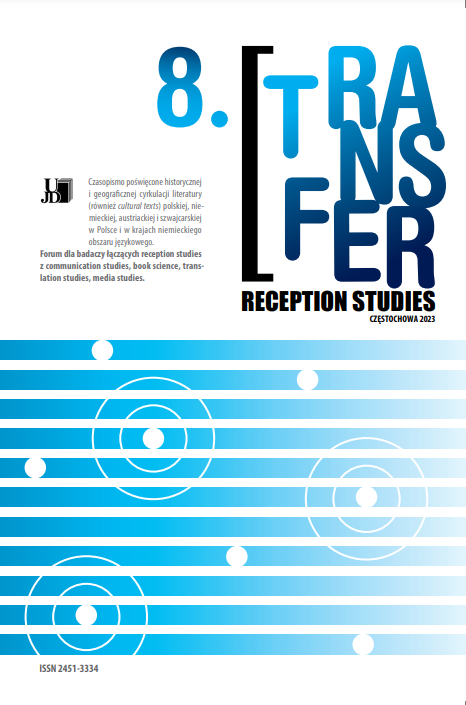Laughter in the comedies of the Skamander environment. Functions and types
Abstract
Laughter in the comedies of the Skamander environment. Functions and types
The author based on three works created in the Skamander environment, Złodziej idealny ["The Ideal Thief"] Jarosław Iwaszkiewicz (written in 1923-1924), Powrót mamy ["Mother's Return"] (1935) and Baba-Dziwo (1938) by Maria Pawlikowska-Jasnorzewska, showed various types and functions of laughter.
In the presented world, she found manifestations of somatic laughter, expressing the joy of life or madness, and committed, possessing the power to change reality and break down the existing forms. The heroes also use laughter as masks, covering surprise, fear or embarrassment. In this way, they transform the controversy into a conversation. They also refer to the social role of laughter, to create a community, define its boundaries, establish the group's personal status or agree on attitudes and behaviors.
Literary images of laughing people have also become examples of cultural laughter, which is why the author showed the comedic work of the Skamander community in the context of the practices of Young Poland and the Interwar period. At the same time, she opposed bringing the Skandiric "gesture of laughter" exclusively to joyful self-acceptance.
Keywords:
the Skamander environment, Interwar period comedies, gesture of laughter, somatic laughter, cultural laughter, Maria Pawlikowska-Jasnorzewska, Jarosław IwaszkiewiczReferences
References
Bauman, Zygmunt. Kultura jako praxis. Translated by Jacek Konieczny. Warszawa: Wydawnictwo Naukowe PWN, 2012. Google Scholar
Biernacki, Andrzej. “Iwaszkiewicz w kręgu Wilde’a.” Dialog (1983), no. 9: 88–90. Google Scholar
Boy-Żeleński, Tadeusz. “Śmiech.” Wiadomości Literackie (1932), no. 39: 1–2. Google Scholar
Boy-Żeleński, Tadeusz. Pisma. Vol. 18: Felietony, 7–29. Warszawa: Państwowy Instytut Wydawniczy, 1959. Google Scholar
Czarnik, Jacek. “Spółka autorska Witkacy – Pawlikowska.” Dialog, no. 1 (1987): 121–127. Google Scholar
Grzymała-Siedlecki, Adam. “Dialog o upadku sztuki aktorskiej.” Museion, no. 1 (1911): 54–72. Reprint in Myśl teatralna Młodej Polski. Antologia, edited by Irena Sławińska, and Stefan Kruk, Foreword by Irena Sławińska, Author’s Notes by Bożena Frankowska, 344–364. Warszawa: Wydawnictwo Artystyczne i Filmowe, 1966. Google Scholar
HistoRisus. Historie śmiechu / śmiech [w] historii, edited by Rafał Borysławski, and Justyna Jajszczok, and Jakub Wollf, and Alicja Bemben. Katowice: Wydawnictwo Uniwersytetu Śląskiego, 2016. Google Scholar
Iwaszkiewicz, Jarosław. Dramaty, Vol. 2. Warszawa: Czytelnik, 1984. Google Scholar
Iwaszkiewicz, Jarosław. “Oscar Wilde i moderne idee w jego dziełach.” Dialog, no. 9 (1983): 78–88. Google Scholar
Kosowska, Ewa. “Śmiech niewesoły.” In Śmiech Sienkiewicza. Śmiech z Sienkiewicza, edited by Agnieszka Kuniczuk-Trzcinowicz, and Zdzisława Mokranowskiej, 43-60. Warszawa: Wydawnictwo DiG, 2017. Google Scholar
Kozłowska, Justyna. “Kohelet z wodewilu.” Dialog, no. 5 (2005): 148–153. Google Scholar
Krasiński, Edward, „Listy Arnolda Szyfmana z Jarosławem Iwaszkiewiczem 1930–1964.” Pamiętnik Teatralny, no. 1/4 (1982): 213–231. Google Scholar
Nowaczyński Adolf. “Skamander połyska wiślaną świetlący się falą.” Skamander, no. 7/9 (1921): 296–317. Google Scholar
Nycz, Ryszard. “Gest śmiechu. Z przemian świadomości literackiej początku wieku XX (do pierwszej wojny światowej).” In Nycz, Ryszard. Język modernizmu. Prolegomena historycznoliterackie. Wrocław: FNP “Leopoldinum”, 2002. Google Scholar
Pawlikowska-Jasnorzewska, Maria. Dramaty, Vol. 1–2, edited by Anna Bolecka, foreword by Stefan Treugutt. Warszawa: Czytelnik, 1986. Google Scholar
Propp, Władimir Jakowlewicz. O komizmie i śmiechu. Translated by Paulina M.E. Knyż. Kraków: Zakład Wydawniczy “Nomos,” 2016. Google Scholar
Puzyna, Konstanty. [Ta wczesna komedia…]. Dialog (1980), no. 4: 7–8. Google Scholar
Ratajczakowa, Dobrochna. “Komedia w epoce Młodej Polski.” In Ratajczakowa, Dobrochna W krysztale i w płomieniu. Studia i szkice o dramacie i teatrze, Vol. 1., 301–312. Wrocław: Wydawnictwo Uniwersytetu Wrocławskiego, 2006. Google Scholar
Redakcja. “Krytykom i recenzentom.” Skamander, no. 4 (1921): 80–87. Google Scholar
Rittner, Tadeusz. “Komedia.” Kurier Warszawski, no. 285 (1911): 5–6. Google Scholar
Słonimski, Antoni. “Ruch teatralny. Teatr Mały: ‘Niewinna grzesznica,’ komedia współczesna i wieczna w 3 aktach Wacława Grubińskiego; dekoracje Karola Frycza, reżyserował autor.” Wiadomości Literackie (1925), no. 13. Google Scholar
Urbanowski, Maciej. “Gest śmiechu w literaturze dwudziestolecia międzywojennego (rekonesans).” Wielogłos, no. 1 (2007): 119–129. Google Scholar
“Varia” [Dn. 6 grudnia…]. Skamander (1920), no. 1: 56–57. Google Scholar
Warońska, Joanna. “Komedia według skamandrytów (wstępny rekonesans).” In Skamander, Vol. 11: reinterpretacje, edited by Maciej Tramer, and Agnieszka Wójtowicz, 11–28. Katowice: Wydawnictwo Uniwersytetu Śląskiego, 2015. Google Scholar
Authors
Joanna Waronskaj.waronska@ujd.edu.pl
Jan Dlugosz University in Częstochowa (Częstochowa) Poland
Statistics
Abstract views: 125PDF downloads: 79
Similar Articles
- Tobiasz Janikowski, "Will my tears change anything?” Manifestations of sadness in German music of the 18th century , Transfer. Reception Studies: Vol. 5 (2020)
- Dana Radler, ‘TOUCHED’ BY HUMOUR IN LIFE: CHARACTERS IN JOHN MCGAHERN’S FICTION , Transfer. Reception Studies: Vol. 5 (2020)
- Jan Trna, Crying and laughing as the pillars of criticism of Switzerland in the play Twenty Thousand Pages by Lukas Bärfuss , Transfer. Reception Studies: Vol. 5 (2020)
- Ivan ZYMOMRYA , The Dilution of Identity in the Artistic Concept of Emma Andijewska , Transfer. Reception Studies: Vol. 4 (2019)
- Jolanta Pacyniak, Narrative structures of threat in "1000 Coils of Fear" ("1000 Serpentinen Angst") by Olivia Wenzel , Transfer. Reception Studies: Vol. 8 (2023): Anxiety and fear in contemporary German-language, Polish and Irish literature
- Joanna Drynda, On Fear and Anxiety in Friederike Gösweiner’s Novels , Transfer. Reception Studies: Vol. 8 (2023): Anxiety and fear in contemporary German-language, Polish and Irish literature
- Monika WÓJCIK-BEDNARZ, Crossing the boundaries in Austrian novels: Engel des Vergessens by Maja Haderlap and Stillbach oder die Sehnsucht Sabine Gruber , Transfer. Reception Studies: Vol. 3 (2018)
- Karolina MATUSZEWSKA, „To get out of the shade, wardrobe and cellar" - an international literary translation programme „TransStar Europa" and its influence over the reception of German- -speaking literature of the 20st and the 21st centuries in Poland , Transfer. Reception Studies: Vol. 1 (2016): CIRCULATION OF GERMAN-LANGUAGE AND POLISH LITERATURE IN THE XXI CENTURY
- Rafał Pokrywka, The Ironical Mode in the Contemporary Romance Novel , Transfer. Reception Studies: Vol. 5 (2020)
- Nick MEISTER , From Prague to Cracow. A few remarks to the profession of a DAAD lecturer , Transfer. Reception Studies: Vol. 4 (2019)
You may also start an advanced similarity search for this article.

